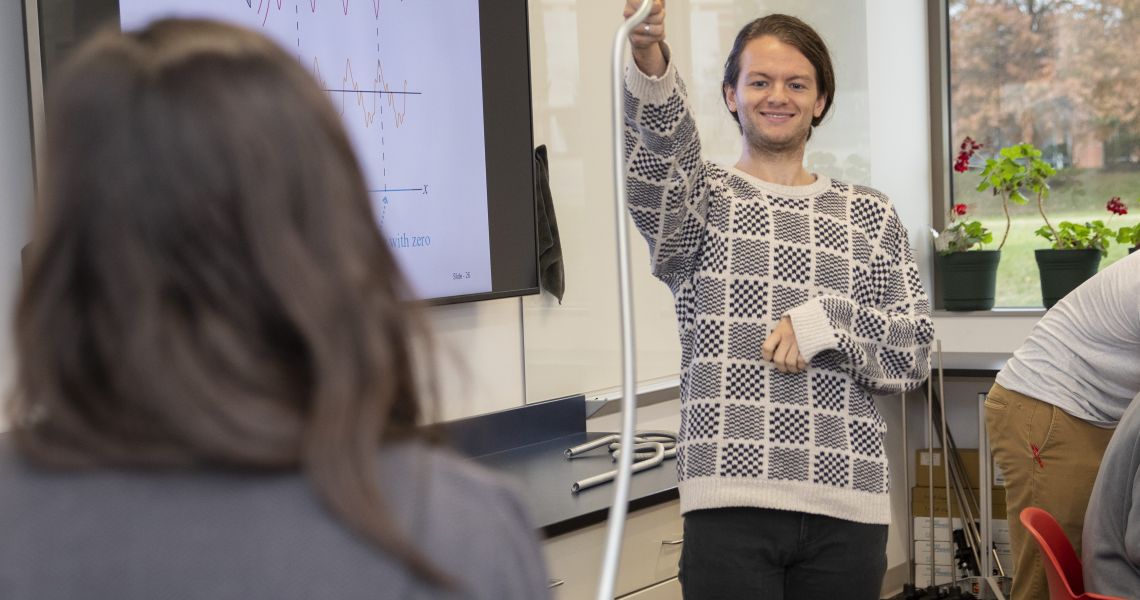
- General Chemistry I
-
Introduction to the fields of physical and inorganic chemistry. Topics to be discussed include atomic structure, chemical bonding, common types of reactions, stoichiometry, thermochemistry and the properties of gases, liquids, and solids. Didactic lectures are augmented by a corresponding hands-on laboratory component. (4 Credits)
- General Chemistry II
-
A continuation of General Chemistry I, topics include kinetics, equilibrium, acid-base chemistry, precipitation reactions, coordination chemistry, thermodynamics, and electrochemistry. Didactic lectures are augmented by a corresponding hands-on laboratory component. (4 Credits)
- Physics I
-
Classical physics, including mechanics, Newton’s laws of motion, force, gravitation, equilibrium, work and energy, momentum, and rotational motion; periodic motion, waves, and sound; heat and thermodynamics. Didactic lectures are augmented by a corresponding hands-on laboratory component. (4 Credits)
- Physics II
-
A continuation of Physics I including electrostatics, electromagnetism, direct and alternating current circuits, and electromagnetic radiation; geometrical and physical optics; special relativity; quantum theory; atomic physics; nuclear physics; particle physics; astrophysics and cosmology. Didactic lectures are augmented by a corresponding hands-on laboratory component. (4 Credits)
- Organic Chemistry I
-
The overall objective of the course is to build knowledge of synthetic organic chemistry through the exploration of the reactivity and potential biological activity of chemicals with different functional groups. Didactic lectures are augmented by a corresponding hands-on laboratory component. (4 Credits)
- Organic Chemistry II
-
Organic Chemistry II builds upon the concepts of Organic Chemistry I and introduces more advanced synthetic concepts and techniques. Reactions are combined in a step-wise process, enabling the student to create complex and interesting organic molecules. Spectroscopic methods are used for the determination of organic structures, and combine that information with chemical observations to deduce the structures of increasingly complex substances. The semester concludes with an examination of the chemistry of biologically important macromolecules. Didactic lectures are augmented by a corresponding hands-on laboratory component. (4 Credits)
- Biology I
-
This course will develop a strong foundation in biological chemistry, cell biology, and genetics. Didactic lectures are augmented by a corresponding hands-on laboratory component. (4 Credits)
- Biology II
-
Topics include biological evolution, biological diversity (microbes, plants, and animals), animal physiology, and ecology. Didactic lectures are augmented by a corresponding hands-on laboratory component. (4 Credits)
- Biochemistry
-
The chemical properties of low molecular weight biochemical molecules, macromolecules and supermolecular complexes essential for life are discussed in addition to basic reaction mechanisms and the integration and regulation of biochemical processes. (3 Credits)
- Current Topics in Health Care I
-
This course is the first part of a two-course sequence for students who plan to become health care professionals. Students learn about core tenets of the US healthcare system, roles and scope of practice of healthcare professions, and current issues in healthcare. The course prepares students to identify their career goals within healthcare. (1 Credit)
- Current Topics in Health Care II
-
Students learn about current topics in healthcare and how these apply to the needs of diverse populations and the delivery of healthcare. The course prepares students to identify their career goals as they related to current issues in healthcare (1 Credit)
- Human Anatomy and Physiology I
-
The study of the structure and function of the human body including cells, tissues and organs of the following systems: skin, musculoskeletal, and nervous. Emphasis is on interrelationships among systems and regulation of physiological functions involved in maintaining homeostasis. Didactic lectures are augmented by a corresponding hands-on laboratory component. (4 Credits)
- Human Anatomy and Physiology II
-
The second course in this series examines the cells, tissues and organs of the following systems: endocrine, cardiovascular, respiratory, digestive, urinary, and reproductive. Emphasis is on interrelationships among systems and regulation of physiological functions involved in maintaining homeostasis. Didactic lectures are augmented by a corresponding hands-on laboratory component. (4 Credits)
- Biostatistics
-
Basic statistical concepts and methods are evaluated, including: confidence intervals, ANOVA, multiple and logistic regression, and non-parametric analyses. The course also explores scientific literature, providing a comprehensive context in which analytical evidence is employed to support practices in the health sciences. (3 credits)
- Medical Terminology
-
Introductory medical terminology course for pre-medical and other pre-health professions students introducing medical vocabulary and terms related to the anatomy, physiology, pathology, and treatment of select systems; the gastrointestinal, respiratory, cardiovascular, blood & lymphatic, integumentary, skeletal, muscular, nervous, urinary, reproductive, endocrine, ophthalmic, and otolaryngology systems. (1 Credit)
- Microbiology
-
Examines the structural and functional characteristics of microbes, prokaryotic
eukaryotic and viruses, in the context of human health. (3 Credits) -